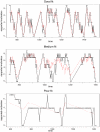Humans and insects decide in similar ways
- PMID: 21170378
- PMCID: PMC2999526
- DOI: 10.1371/journal.pone.0014251
Humans and insects decide in similar ways
Abstract
Behavioral ecologists assume that animals use a motivational mechanism for decisions such as action selection and time allocation, allowing the maximization of their fitness. They consider both the proximate and ultimate causes of behavior in order to understand this type of decision-making in animals. Experimental psychologists and neuroeconomists also study how agents make decisions but they consider the proximate causes of the behavior. In the case of patch-leaving, motivation-based decision-making remains simple speculation. In contrast to other animals, human beings can assess and evaluate their own motivation by an introspection process. It is then possible to study the declared motivation of humans during decision-making and discuss the mechanism used as well as its evolutionary significance. In this study, we combine both the proximate and ultimate causes of behavior for a better understanding of the human decision-making process. We show for the first time ever that human subjects use a motivational mechanism similar to small insects such as parasitoids and bumblebees to decide when to leave a patch. This result is relevant for behavioral ecologists as it supports the biological realism of this mechanism. Humans seem to use a motivational mechanism of decision making known to be adaptive to a heterogeneously distributed resource. As hypothesized by Hutchinson et al. and Wilke and Todd, our results are consistent with the evolutionary shaping of decision making because hominoids were hunters and gatherers on food patches for more than two million years. We discuss the plausibility of a neural basis for the motivation mechanism highlighted here, bridging the gap between behavioral ecology and neuroeconomy. Thus, both the motivational mechanism observed here and the neuroeconomy findings are most likely adaptations that were selected for during ancestral times.
Conflict of interest statement
Figures






References
-
- Waage JK. Foraging for patchily-distributed hosts by the parasitoid, Nemeritis canescens. Journal of Animal Ecology. 1979;48:353–371.
-
- Lefebvre D, Pierre JS, Outreman Y, Pierre J. Patch departure rules in Bumblebees: evidence of a decremental motivational mechanism. Behavioral Ecology and Sociobiology. 2007;61:1707–1715.
-
- Hutchinson JMC, Wilke A, Todd PM. Patch leaving in humans: can a generalist adapt its rules to dispersal of items across patches? Animal Behaviour. 2008;75:1331–1349.
-
- Wilke A, Todd PM. Past and present environments: The evolution of decision making. Psicothema. 2010;22:4. - PubMed
Publication types
MeSH terms
LinkOut - more resources
Full Text Sources
Research Materials
Miscellaneous

